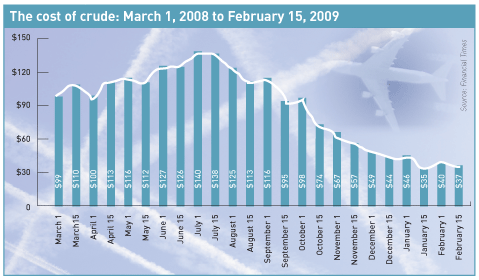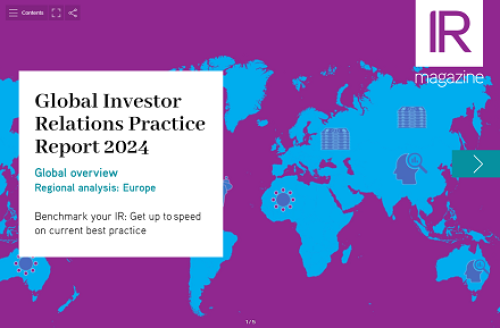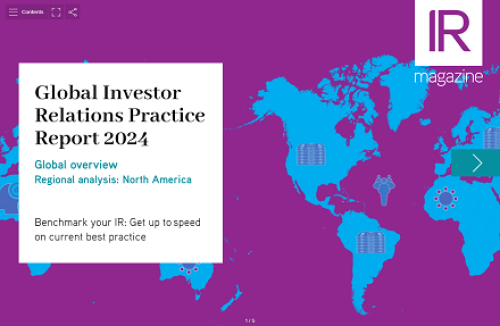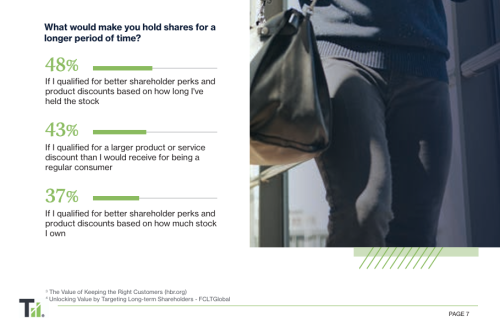Oil-price volatility means hedging losses while IR teams stress competitive advantage
When crude oil prices started to fall after peaking at over $140 a barrel in July last year, it seemed like a rare piece of good news for the troubled airline industry. Dozens of smaller operators had gone bust in the first half of 2008 as the economic slowdown and the credit crunch took their toll, and the outlook was deteriorating by the day.
But the dramatic collapse in oil prices caught the industry unawares and left airlines nursing billions of dollars in losses from fuel-hedging strategies that had been put in place right at the top of the market.
From Air China to Southwest Airlines, few have been spared, although some of the ailing US airlines were so low on cash they found it difficult to take out significant hedging positions. Merrill Lynch estimated that nine major Asian airlines alone are likely to have racked up losses from fuel hedging of $3.8 bn in 2008, with Merrill analysts Paul Dewberry and Ying Ying Hou also warning that ‘the Asian airline sector faces the deepest and most prolonged downturn since the global recession of 1980-1982.’
Were these losses the result of well-meaning but erroneous predictions or were airlines trying to play the oil market when they should have been hedging out the risk? With airlines taking such a diverse range of approaches to fuel hedging, it is hard to generalize.
But air industry IROs insist they were not gambling. They say the extreme volatility in oil prices made it very difficult for them to get it right, and that they will, in any case, be able to make up many of the paper losses from bad hedges in the real jet-fuel market.
Accounting for change
Dominique Barbarin is senior vice president of IR at Air France-KLM, which slipped into the red in the last quarter of 2008 after notching up a €288 mn ($361 mn) loss from bad bets on fuel. She says the loss was the result of IFRS, which requires firms to report changes in the fair value of financial instruments such as fuel hedges.
‘The volatility of oil prices makes it more efficient to hedge,’ Barbarin explains. ‘The challenge comes when, due to a drop in the oil price, you have to post some financial charges linked to the value of options. It’s an accounting fact, and it’s important to demonstrate that the fundamentals of the group and its strategy remain the same. The main problem is trying to explain how IFRS works; the scheme is difficult for some investors to understand.’
Barbarin adds that the negative impact of hedging on the airline’s financial accounts will be felt only in the short term. ‘Air France-KLM was certainly one of the most-hedged airlines around and we benefited from this over the last six years,’ she says. ‘We’re not in a terribly favorable situation right now but we were able to unwind a lot of the hedging contracts and can now take advantage of the drop in the fuel price.’
This last point is an important one. If an airline has hedged half its fuel requirements for the year ahead at, for example, $120 a barrel, clearly further falls in the oil price will increase the value of the mark-to-market loss on the hedge. But this drop in the oil price will also allow the airline to benefit from buying cheaper fuel.
When Hong Kong-based Cathay Pacific unveiled a profits warning tied to a HK$7.6 bn ($980 mn) unrealized loss on fuel hedges at the start of the year, it noted: ‘The Cathay Pacific group has benefited (and will continue to benefit) from the reduction in oil prices notwithstanding the mark-to-market losses. Had the jet-fuel price remained at its July 2008 peak, the cash costs of buying fuel in 2008 would have been around HK$7.9 bn higher than they proved to be.’
Tom Horton, CFO of American Airlines’ parent company AMR, also felt obliged to defend the airline’s hedging policy on a recent post-results conference call, telling analysts that it is ‘designed to dampen the impact of fuel price volatility, and is not designed to take risky speculative bets on what we believe the price will be at a specific point in the future. When fuel prices rise, hedges can buffer expense increases; when fuel prices are falling, hedges will offset some of that favorable impact.’
The best bet
Fuel has always been one of the biggest single expenses faced by airlines and debates about the best fuel-hedging strategies are nothing new. ‘It’s a topic that’s debated internally on a daily – if not hourly – basis,’ comments David Broderick, head of investor relations at Ryanair, the Irish no-frills carrier.
What was different this time was the speed with which oil prices spiked and then collapsed. The price of a barrel of Brent crude started rising steadily from around $55 a barrel at the beginning of 2007 but many airline executives resisted the urge to take out hedges because they believed that after such a big price rise, the market would have to correct sooner or later.
‘At $80 or $90 a barrel, airlines started to lose their nerve, especially with good old Goldman Sachs talking the market up to $200 a barrel and beyond,’ says Peter Harbison, executive chairman of the Centre for Asia Pacific Aviation, a research firm based in Sydney, Australia. ‘Many airline boards were reading so much about rising oil prices they felt they had to hedge, for corporate governance purposes: they thought they would be viewed as irresponsible if they didn’t.’
Ryanair’s chief executive, Michael O’Leary, was one of those who held out for as long as possible in the first half of 2008 in the belief the oil price would soon fall back. When it continued to move above $100, he conceded that he had ‘screwed up’ and eventually took out hedges in September, only to see the price of crude slide and Ryanair suffer its worst-ever Christmas trading quarter as its fuel bill soared.
This turbulence has not made life easy for Broderick, although he believes Ryanair’s transparent approach has helped to mitigate the damage to investor confidence. ‘Shareholders have appreciated our openness with the market,’ he says. ‘We’d seen a massive spike and then oil came down quite considerably. We have to make decisions in this business; sometimes we get them right, sometimes we get them wrong. But we weren’t trying to beat the market, we were trying to get a degree of certainty in an area that is a substantial part of our cost base.’
Investors need to take a long-term view on hedging, according to Brian O’Neal, an expert in fuel hedging and risk management at KPMG in Houston, Texas. ‘All gains or losses should be considered in a multi-year context to help inform a decision on whether management’s hedging decisions add value over five or 10 years.’
As a cyclical industry, airlines are heavily exposed to the worsening global slowdown and investors are looking for reassurance. With around 30 operators going bust last year, IROs say it is more important than ever to ensure investors understand the sustainability of their business models.
‘The question investors are asking is, Are you able to weather this crisis?’ notes Barbarin. ‘We have to take a more pedagogic approach, hold more meetings and roadshows and demonstrate the strength of our assets and our competitive advantages. It doesn’t necessarily mean the fund managers will invest now but, when the rebound comes, if you’ve been there with them in the tough times, they may be more interested in your story.’
Broderick adds: ‘Whether it’s blue skies or black, we’re always trying to communicate the short-term sustainability and long-term success of our business model.’











